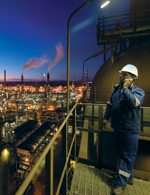|
Two giant petrochemical plants near Johannesburg are among the first large TETRA users in Southern Africa. Richard Lambley visited them to learn about their experience "The miners call this plant the beast”, says John Rush, at the Secunda site of Sasol, the South African fuel and petrochemicals giant. “It swallows everything! It’s an amazing plant.” Standing in the plains some 130 km east of Johannesburg, this immense complex occupies more than 13 square kilometres, with its vistas of towers and tanks and furnaces and pipelines and railway tracks, its coal stockpiles and ash mountains. Five deep coal mines in the surrounding countryside feed it with the raw material for Sasol’s keynote activity – converting coal into motor fuels and a broad range of other chemical outputs. Each day, the plant consumes 110 000 tonnes of coal – a quantity which, stacked on a rugby football pitch, would stand three storeys high. It also swallows 265 million litres of water daily. And by the miracles of large-scale industrial chemistry, these raw materials are also the starting point for more than 200 other high-value products – from plastics, fertilizers and mining explosives to industrial gases and even aspirin. Because South Africa has no natural oil resources, the Secunda plant (and the company’s original site at Sasolburg, southwest of Johannesburg) are critical to the national economy and to everyday life. And so their TETRA radio communications networks, which John Rush manages, are of vital importance in keeping the processes running smoothly and safely. “Previous to this we had 50 frequencies here, a mixture of conventional and simplex systems”, says John, radio specialist at Sasol Secunda. “Sasol Mining was on VHF and Sasol Synfuels on UHF. TETRA has consolidated the frequencies, making it much easier to communicate.” High sitesFor John, the new installation is the third radio system he has overseen at the plant – and, with its TETRA infrastructure by Rohde & Schwarz Mobilfunk (now a division of Hytera), it is easily the most advanced. Using 13 ‘high sites’ (radio sites) linked together in five interlocking rings, it provides digital communications not only for the plant itself, with up to 5000 radio users, but also across more than 4000 square kilometres of the surrounding landscape. With this extended coverage, the system reaches not only the surface levels at the mines but transit routes and homes in between, enabling key personnel and emergency services to be contacted. At the site itself, production is a complex sequence of linked and co-ordinated processes, and each one must be kept running steadily. Any hitches will cause disruption further down or up the chain. On top of all this activity, radio plays a key role in managing the annual maintenance shutdown in September, when as many as 12 000 outside contractors may be brought in to work on the site. The scalable TETRA technology also allows the system to grow as communications needs increase. Already the Secunda site has been duplicated to create a pair of identical plants, on its eastern and western sides, and its operator Sasol Synfuels has a further expansion in the planning stage. Radio for growth“We’re extremely proud of the implementation of TETRA here”, comments Sasol project manager Christo Kriek, who was responsible for the installation work. “We think that this is one of the best implementations of a system like this in an industrial environment that you could get.” The case for change, he explains, was that the previous radio system – an MPT network supplemented by VHF conventional radios at the mines – was nearing the end of its life. Needs were emerging for clearer speech quality, voice recording and position-finding to locate staff. In addition, with 50 radio frequencies in use on the site, there was a serious spectrum congestion problem. “We needed to get ourselves geared up for future growth”, Christo continues. “Communication is one of the things in any company that is most important. If you ask anybody what is the biggest problem in their company, you will find that it’s communication – either from management to people or among the people.” On the wish-list for the new system were many of the features that TETRA is designed to provide – secure, mission-critical communications with efficient spectrum usage (“We think about that three times a day”, Christo says), emergency fallback, priority levels for users, interconnection with cellular phones, and support for a variety of user applications. In addition, a TETRA system would be able to replace radio pagers and the increasing use of mobile phones on the plant. “We have found in emergencies that cellular communications just crashes”, John Rush puts in.
|

